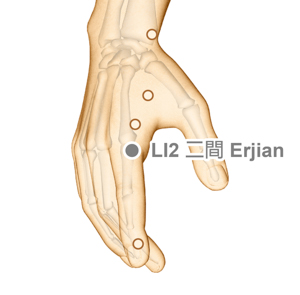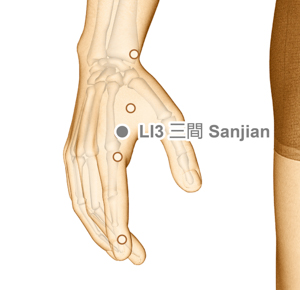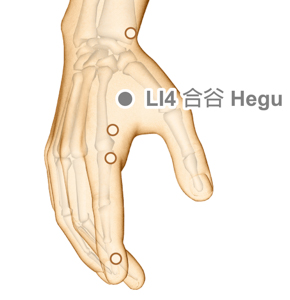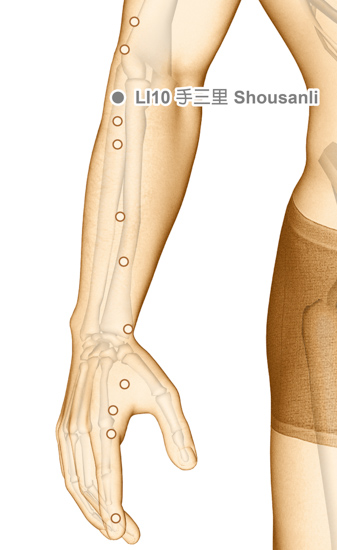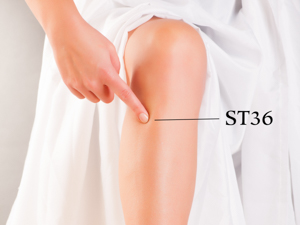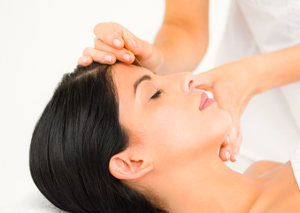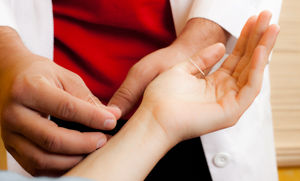LI2 is a ying-spring, water, and son point. Traditional indications include epistaxis, toothache, sore throat, and fever. LI3 is a shu-stream and wood point. Traditional indications include toothache, eye disorders, sore throat, and inflammation of the hand.
The flow of qi from LI2 to LI3 is similar to the flow of qi from in front of a small hill to behind the hill. At LI2, the qi is resting and getting ready to traverse the hill. At LI3, the qi is ready and is exposed, it will eventually grow in power to the valley of LI4 (Hegu). This is a reflection of the point’s anatomical location. The qi flows from the depression distal to the metacarpo-phalangeal joint (front of the hill) to the depression proximal to the joint (behind the hill). The qi is growing in power as it moves toward LI4. We say the qi is maturing from LI2 to LI3. We can also say it is developing, from a relatively undeveloped state to a more developed state. We say the qi is gathering strength from the underground spring (ying-spring point) to the stream (shu-stream point) above ground.
The energy behind the bone matures and blossoms at LI3 as it travels from LI2; therefore, LI3 is more for mature (developed) symptom presentations. LI2 is more for immature (undeveloped) symptoms because the qi has not yet grown. For example, a skin rash that is hiding under the skin is immature and therefore LI2 is appropriate. Once the rashes expresses, we say it has matured and therefore LI3 is a better choice.
More in Course Materials…
LI4 is on the dorsum of the hand, between the first and second metacarpal bones, approximately at the midpoint of the second metacarpal bone on the radial side. When squeezing the thumb against the index finger, LI4 is at the highest point of the muscle bulge, approximately level with the end of the crease.
LI4 is a yuan-source point and an entry point. LI4 disperses the wind, release the exterior, eliminates pain, and clears the channels. Traditional indications include headaches, eye pain, epistaxis, toothaches, deafness, facial edema, facial paralysis, sore throat, trismus (locked jaw), fever, delayed labor, local pain, and general pain. Combined with KD7, this point is used for insufficient sweating. In addition, this point is often used with SP6 with electroacupuncture for the treatment of delayed labor.
LI4 is a Gao Wu command point for the treatment of face and mouth disorders. LI4 is a Ma Dan-yang heavenly star point, indicating that this point is an important and powerful point, especially for indications such as headaches, facial swelling, malaria, fever, chills, and toothaches. This acupuncture point is contraindicated during pregnancy, especially when there is qi and blood deficiency.
The lung and large intestine are paired organs in the Chinese medicine system. Both organs have the function of clearing and expelling stagnation. The lungs are capable of expelling stagnant foreign objects and phlegm and the large intestine are responsible for eliminating stagnated stool. This point powerfully eliminates stagnation and has the energy of both the lungs and large intestine.
According to five element theory, the lungs are correlated with the white tiger. The tiger is strong and gets rid of anything he/she does not like. LI4 shares the lung channel power of the tiger and is used to eliminate excess and exterior conditions. This is, in part, due to the lung and large intestine being paired organs.
The lung channel “white tiger” and LI4 share the tiger’s power and name. One historical name for LI4 is tiger mouth. The reference to tiger mouth comes from ancient Chinese culture, especially from the martial arts. In the martial arts, applying pressure to this point creates powerful reactions and can subdue an opponent. This is one power of the tiger. In addition, the shape of LI4 is a reference to a tiger’s mouth. It is where the thumb and index finger open like a tiger’s mouth.
The large intestine has the power of moving stagnation and this power is expressed in this acupoint’s ability to eliminate things that are not healthy. With the power of the lung tiger and large intestine, LI4 powerfully…
More in Course Materials…
LI10 is on the line joining LI5 and LI11, 2 cun distal to LI11.
Although the character li (里) in the name of the point is translated as mile, it is technically shorter than a mile. Although there have been variations in this traditional measurement over time, 1 li is approximately 0.3 miles or 0.5 km.
Note: the literal translation of Shou (手) is hand, but this is also used to refer to the arm as in Shouwuli (LI13, Arm Five Miles). The character for hand is also cultural reference to the arm when used for the name of LI13.
LI10 is synchronized with ST36 (Zusanli, Leg Three Miles). The reference to the synchronization is within the names of the points: Arm Three Miles, Leg Three Miles. Anatomically, LI10 and ST36 are in similar locations distal to the elbow and knee respectively. As a result, they communicate with each other, which is reflected in the names. These are paired points that are used to tonify qi. LI10 clears the large intestine channel pathway and assists the strengthening function of ST36 to benefit the stomach and spleen.
LI10 has a powerful function to reduce stagnation and is therefore effective for invigorating qi and blood circulation to the arm, elbow, rotator cuff, and scapula. For example, when a patient has frozen shoulder syndrome, this point can be needled while passive or active motion is exerted, which frees mobility in the arm and shoulder. For any shoulder or arm pain, this point provides a deep…
More in Course Materials…
A famous 7th century physician, Sun Simiao, wrote a treatise entitled On the Absolute Sincerity of Great Physicians. This was a section of the work entitled The Important Prescription Worth a Thousand Pieces of Gold. The treatise is sometimes referred to as the Chinese Hippocratic Oath. The treatise “requires the physician to develop first a sense of compassion and piety, and then to make a commitment to try to save every living creature, to treat every patient on equal grounds, and to avoid seeking wealth because of his expertise.” [1] Sun Simiao commented on relations with colleagues, “it is inappropriate to emphasize one’s reputation, to belittle the rest of the physicians and to praise only one’s own virtue.”
1. Veatch, Robert M. Cross-cultural perspectives in medical ethics. Jones & Bartlett Learning, p 320-321, 2000.
More about Sun Simiao in the Course Materials…
Acupuncture repairs injured nerves. Findings published in Neural Regeneration Research demonstrate that acupuncture causes injured lower and upper limb motor nerves to repair. Electromyographic nerve conduction tests of acupuncture patients with nerve injuries document “an effective response” in 80% of patients participating in the study. Electromyography confirms that acupuncture significantly improves motor nerve conduction velocity and amplitude and also promotes functional nerve repair.
The researchers made an important discovery. A special set of acupuncture points resulted in good to excellent clinical responses at a very high rate. Using only local acupuncture points, patients had an effective rate of 38.5%. By adding acupuncture points to the…
More in Course Materials…
Acupuncture alleviates nasal and eye itching, sneezing, and runny nose for patients with allergic rhinitis. Researchers confirm that acupuncture successfully downregulates IgE (immunoglobulin E), an antibody active in hypersensitivity reactions, while simultaneously reducing symptoms of allergic rhinitis. In a controlled investigation published in the Annals of Allergy, Asthma & Immunology, university researchers demonstrate that acupuncture downregulates allergen specific IgE for dust mites.
Researchers from Stanford University, RMIT University, Griffith University, and Western Sydney University conclude that acupuncture…
More in Course Materials…
Acupuncture relieves carpal tunnel syndrome pain and restores function. Two independent studies reveal the benefits of warm needle acupuncture for CTS (carpal tunnel syndrome). Participants in both studies experienced significant improvements in pain levels and wrist function following acupuncture treatment combined with…
More in Course Materials…
MRI studies reveal the neurological mechanisms of acupuncture on human health. Research published in Autonomic Neuroscience demonstrates that stimulation of specific acupuncture points induces hemodynamic changes in specific brain networks. The researchers add that brain networks accessed by specific acupuncture points relate to specific medical disorders and suggest an “acupoint-brain-organ” pathway.
Functional magnetic resonance imaging (fMRI) studies reveal specific acupuncture point effects…
More in Course Materials…
